Hampshire College
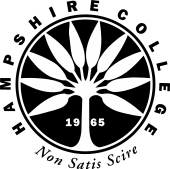 | |
| Motto | Non satis scire |
|---|---|
Motto in English | To Know is Not Enough |
| Type | Private |
| Established | 1965 |
| Endowment | $48.5 million[1] |
| President | Miriam E. Nelson |
Academic staff | 165[1] |
Administrative staff | 115 |
| Undergraduates | 1,321 (Fall 2016)[2] |
| Location | Amherst, Massachusetts, U.S. |
| Campus | Rural, 800 acres (3.2 km²) |
| Avg. Class Size | 15[1] |
| Colors | Purple, blue, red, maroon, white |
| Website | hampshire.edu |
|
| |
Hampshire College is a private liberal arts college in Amherst, Massachusetts. It was opened in 1970 as an experiment in alternative education, in association with four other colleges in the Pioneer Valley: Amherst College, Smith College, Mount Holyoke College, and the University of Massachusetts Amherst. Together they have since been known as the Five Colleges or the Five College Consortium.
The college is widely known for its alternative curriculum, socially liberal politics, focus on portfolios rather than distribution requirements, and its reliance on narrative evaluations instead of grades and GPAs. In some fields, it is among the top undergraduate institutions in percentage of graduates who enroll in graduate school. Sixty-five percent of its alumni have at least one graduate degree and a quarter have founded their own business or organization.[3] It is ranked #39 among U.S. colleges and universities by the percentage of graduates who go on to earn a doctorate degree according to National Science Foundation data.[4]
History
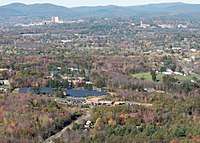

The idea for Hampshire College originated in 1958 when the presidents of Amherst, Mount Holyoke, and Smith Colleges, and the University of Massachusetts Amherst, appointed a committee to examine the assumptions and practices of liberal arts education. Their report, "The New College Plan[5] ", advocated many of the features that have since been realized in the Hampshire curriculum: inviting students to self-design their program of studies; training students to be able to educate themselves through their lifetimes; emphasis on each student's curiosity and motivation; learning among and across multiple disciplines; and close mentoring relationships with teachers.[6]
In 1965, Amherst College alumnus Harold F. Johnson, inspired by the New College Plan, donated $6 million toward the founding of Hampshire College. With a matching grant from the Ford Foundation, Hampshire's first trustees purchased 800 acres (3.2 km2) of orchard and farmland in South Amherst, Massachusetts, and construction began.
One of the most significant founding documents of Hampshire College is the book The Making of a College (MIT Press, 1967; ISBN 0-262-66005-9), co-written by the College's first president, Franklin Patterson, together with Hampshire's founding employee from Amherst College who would become its second president, Chuck Longsworth. The Making of a College is (as of 2003) out of print but available in electronic form from the Hampshire College Archives.[7]
Hampshire admitted its first students in 1970.[8] For several years immediately after its founding in the early 1970s, the large number of applications for matriculation caused Hampshire College to be among the most selective undergraduate programs in the United States.[9] Its admissions selectivity declined thereafter because of declining application popularity. The school's number of applications increased again in the late 1990s, causing increased admissions selectivity since then. The college's rate of admissions is now comparable to that of many other small liberal arts colleges.
The school has been financially challenged through much of its history, in large part because it lacked a founding endowment to rely on for stability of income, and it has relied substantially on tuition income for operations. As of June 30, 2017, the endowment had risen to $48.5 million.[10] In recent years, the school has been on more solid financial footing, though still lacking a sizable endowment. In recent years its financial stability has relied on fundraising efforts led by its most recent president, Jonathan Lash.
In the mid-1990s, the college began establishing a "cultural village" making possible the residence of independent non-profit organizations on its campus. The cultural village[11] includes the National Yiddish Book Center, the Eric Carle Museum of Picture Book Art and The Hitchcock Center for the Environment.

Adele Simmons served as the College's third president, from 1977 to 1989, the longest tenure of any Hampshire President. Gregory Prince served as its fourth president, from 1989 to 2005.
On April 1, 2004, Prince announced his retirement, effective at the end of the 2004–2005 academic year. On April 5, 2005, the Board of Trustees named Ralph Hexter, formerly a dean at University of California, Berkeley's College of Letters and Science, as the college's next president, effective August 1, 2005. Hexter was inaugurated on October 15, 2005. The appointment made Hampshire one of a small number of colleges and universities in the United States with an openly gay president.[12]
Professor Marlene Gerber Fried was interim president for one year from 2010 to 2011. Jonathan Lash was named the sixth president of the College in May, 2011, joining Hampshire as an internationally recognized expert on global sustainability, climate change, and environmental challenges and solutions. He has been appointed by two US Presidents to serve on a national environmental council and commission. Lash served a long tenure until 2018, and is followed by the College's seventh president, Miriam Nelson, beginning her appointment in July, 2018.[13]
The Hampshire College Archives in the Harold F. Johnson Library has extensively documented the College's history between 1965 and 2005, accessible on the College's Website.[14]
On August 23, 2012, the school announced the establishment of a scholarship fund dedicated to helping undocumented students get degrees. It would give more than $25,000 each year to help an undocumented student pay for the $43,000-plus tuition.[15]
18th Century Proposal for a College in Hampshire County (unrelated)
Around 1761, an idea for a new college with a different system was debated among settlers and the Massachusetts government. They proposed calling the new institution Hampshire college which, if successful, would have been completely different from Hampshire College today. A group of 74 people in Hampshire County expressed interest in establishing a new college to train their ministers and civil leaders since the other colleges were expensive and far away. Furthermore, they wanted to establish a system that followed their moral standards and was free of religion. Their proposal was denied by the Massachusetts government in attempt to avoid a competition with Harvard College. At the time, Harvard College was recognized by the state as the most suitable college for training ministers; it was feared a new college would weaken Harvard. The group then sought assistance from Lord Jeffry Amherst who also declined support as to not question the Massachusetts government.[16]
Academics and resources
Curriculum
Hampshire College describes itself as "experimenting" rather than "experimental", to emphasize the changing nature of its curriculum. From its inception, the curriculum has generally had certain non-traditional features:
- An emphasis on project work as well as, or instead of, courses
- Detailed written evaluations (as well as portfolio evaluations) for completed courses and projects, rather than letter or number grades
- A curriculum centered on student interests, with students taking an active role in designing their own concentrations and projects
- An emphasis on independent motivation and student organization, both within and without the college's formal curriculum
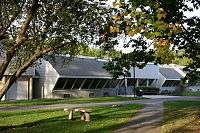
The curriculum is divided into three "divisions" rather than four grade-years:[17]
- Division I: Exploration and Working Across Disciplines[18]
In Division I, the student, mentored by a professor as adviser: a) Completes a minimum of four courses from five broad distribution areas.
- Arts, Design, and Media
- Culture, Humanities, and Languages (language study strongly encouraged for those planning to study abroad)
- Mind, Brain, and Information
- Physical and Biological Sciences
- Power, Community, and Social Justice
b) Completes three elective courses from Hampshire or the Five Colleges. Independent study and special projects are allowed with adviser approval. c) Completes a community-engaged learning activity, devoting 40 hours to campus life d) Submits a year-end portfolio of work and faculty evaluations from courses and electives, including an essay reflecting on Division I, and receives a final written evaluation from the adviser.
- Division II: Concentration[19] (typically years 2 and 3)
Drawing on resources at Hampshire and the Five Colleges and advised by a committee of two faculty members, the student: a) Designs a concentration, starting by writing a plan for four semesters of work that sets out their questions for exploration and goals for developing expertise in the concentration. The plan may be similar to a traditional college major or an original, individualized program encompassing multiple fields, disciplines, and Schools. The plan is considered a contract negotiated with the committee, and may be revised periodically. It may include courses and other activities — independent study/research, community-based learning, internships, study abroad, social action, lab work, teaching/research assistantships, etc. The minimum number of evaluated activities is 12. b) Fulfills a Multiple Cultural Perspectives requirement by completing a course/learning activity centered on an exploration of non-Western perspectives, the roles of race and racism in the U.S., or the dynamics of knowledge, power, and privilege. c) Fulfills a community-engaged learning requirement by devoting at least 40 hours to addressing a community need by volunteering with a community partner; serving an internship, assistantship, or mentorship; completing a course with a community component.
To complete Division II, the student compiles and presents a portfolio to the committee, curating the academic work and reflecting on its meaning and on learning. The portfolio consists of selected works (in any medium), evaluations from courses/learning activities, and a Division II reflection, demonstrating that the student has fulfilled the contract. The student receives a final committee evaluation.
- Division III: Creating Knowledge[20]
The student forms a committee of at least two faculty members and designs an original, yearlong advanced-study project, one that will demonstrate the student’s ability to handle complex questions, concepts, and skills. The student submits the plan as a contract including a description of the purpose and substantive nature of the project; the approach and techniques to be applied; resources and facilities to be employed; and the form the final project will take. The student meets with the committee regularly to report on progress. Faculty will provide reviews, critiques, and guidance throughout and must find the work sufficient to graduate with a bachelor of arts degree.
To successfully complete Division III, the student must: a) Complete the Division III project b) Complete at least two advanced learning activities (e.g. courses at the 300 level or above, a teaching assistantship, an internship, or another activity that broadens the scope of the student’s intellectual endeavor and engages the campus or community at large.
The student submits the final capstone project, performance, presentation, or paper, and meets for the last time with the committee. Committee members write an evaluation of the Division III.
Schools and programs

The Hampshire College faculty are organized broadly in defined Schools of thought:
- Cognitive Science (CS): includes linguistics, most psychology, some philosophy, neuroscience, and computer science.
- Humanities, Arts, and Cultural Studies (HACU): includes film, some studio arts, literature, media studies, and most philosophy.
- Critical Social Inquiry (CSI): includes most sociology and anthropology, economics, history, politics, and some psychology.
- Natural Science (NS): includes most traditional sciences, mathematics, and biological anthropology.
- Interdisciplinary Arts (IA): includes performing arts, some studio arts, and creative writing.
The Five College Program in Peace and World Security Studies (PAWSS) is based at Hampshire; its director is Michael Klare.[21] The national reproductive rights organization Civil Liberties and Public Policy (CLPP) operates on Hampshire's campus, where they host an annual conference.[22] In 2014 Hampshire announced the formation of a new concentration, in Psychoanalytic Studies.[23]
Five College Consortium
Hampshire College is the youngest of the schools in the Five-College Consortium. The other schools are Amherst College, Mt. Holyoke College, Smith College and the University of Massachusetts Amherst.[24]
Students at each of the schools may take classes and borrow books at the other schools, generally without paying additional fees. They may use resources at the other schools, including internet access, dining halls, and so forth. The five colleges collectively offer over 5,300 courses, and the five libraries have over eight million books.[25] The Pioneer Valley Transit Authority (PVTA) operates bus services between the schools and the greater Pioneer Valley area.[26]
There are two joint departments in the five-college consortium: Dance and Astronomy.[27]
Sustainability
The R.W. Kern Center
Opened on April 26, 2017, the R.W. Kern Center is the 17th Living Building in the world certified under the advanced green-building standard, the Living Building Challenge. The building cost $10.4 million made possible by private donations. It operates net-zero energy, water, and waste. The building is powered by solar panels on its roof, supplies its own drinking water by harvesting rainwater from its roof, manages its wastewater on site, and contains composting toilets. The Kern Center was built using materials from local sources without the use of any toxic "red list" materials; even materials such as duct tape were chosen carefully to comply with strict environmental standards.[28] Currently, the Kern Center houses Admissions and financial aid offices as well as classrooms, student lounges, and a coffee shop. President Jonathan Lash stated that "[w]ith this building we have sought to reflect our values, in the inclusive design process, the design and materials, our construction practices, and our reporting about the building... [w]hy are buildings constructed any other way? In every way, the Kern Center was built to learn and teach.”[29][30]
Climate Action Plan
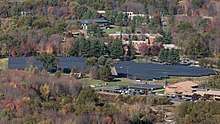
Hampshire College will soon become the first college in the United States to be 100% solar powered, a milestone for the college. They wait for permission to switch to full operation of its solar energy. The solar panel array is a part of the college's main goal - to be climate-neutral by 2020 according to their extensive Climate Action Plan developed in April 2012. They begain construction in February 2015. Two witness tests were conducted in June 2017 and its final one conducted November 2017. Since June 2017, a part of the solar array has been powering the college. The solar panels cover 19 acres consisting of 15,000 panels which will eventually produce 4.7 megawatts of power each year. Hampshire College contracted with SolarCity to install the panels.[31]
The college will save up to $8 million in electricity cost in 20 years and $400,000 yearly. 4.7 megawatts of solar power eliminates 3,000 metric tons of greenhouse-gas emissions per year which is equivalent to 650 less cars on the road. Other solar sources on campus contribute to the main solar array: the Kern Center rooftop solar arrays, the CSA Barn, the president's house, and the Longworth Arts Center canopy atop solar panels. The president stated that "[t]his is the challenge that our students and every other student is going to face in the next 20 years, how to turn the US economy into a low-carbon economy ... and they're going to get the real firsthand experience of doing it. So that was reason number one.” The president has declared that switching to renewable energy is "just the right thing to do in an era of accelerating climate change." He also noted this project will keep jobs local and prevent "pipelines being built through people's communities to get power to our college."[32]
In the next 20 years, the college plans to reduce 50% of current consumption of energy, another major goal stated in their Climate Action Plan. They plan to renovate the Robert Crown Center, Library, Cole Science Center, Franklin Patterson Hall, Merrill House, and Greenwich House. Their plan is possible by a $1 million gift.[33]
Timeline of Sustainability Initiative
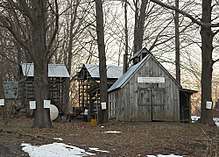
Since 2011, Hampshire College has been involved in various projects to "transform its food systems, campus operations, curriculum and campus culture to embrace sustainability." The college's advances in sustainability include various projects. In 2011, the college was the first in the world to divest from fossil-fuels. In 2012, they developed the Climate Action Plan for climate neutrality by 2022.[34] Hampshire College Farm expanded their education and operation, establishing the Center for New England and Agriculture. In 2014 the main traffic circle and parking lot was eliminated and turned into a meadow. They also stopped mowing dozen acres of lawns in hopes of reducing greenhouse-gas emissions, saving landscaping expenses and creating wildlife and plant habitats. In the same year, they installed an electric car-charging station behind the library.[35] In 2015 they permanently protected 46 acres of their property through a conservation restriction. The Kern Center became their first 100% emission-free building in 2016 and the Hitchcock Center for the Environment built its new living building on Hampshire land. In 2017, Hampshire College pledged to continue to support climate action and reduce carbon emissions in accordance with the Paris Climate Agreement. They signed the We Are Still In campaign along with 2,600 total signers.[36]
Prominent campus issues
Re-Radicalization
In the spring of 2004, a student group calling itself Re-Radicalization of Hampshire College (Re-Rad) emerged with a manifesto called The Re-Making of a College, which critiqued what they saw as a betrayal of Hampshire's founding ideas in alternative education and student-centered learning. On May 3, 2004, the group staged a demonstration that packed the hall outside the President's office during an administrative meeting. Response from the community was generally amicable and Re-Rad made some progress.
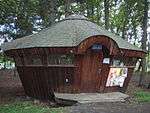
The Re-Radicalization movement was responding in part to a new "First-Year Plan" that changed the structure of the first year of study. Beginning in the Fall of 2002, the requirements for passing Division I were changed so that first-year students no longer had to complete independent projects (see Curriculum above). Re-Rad submitted its own counter-proposal in both 2006 and 2007, but these proposals were not acted on, and no follow-up was attempted.
The Re-Radicalization of Hampshire College assisted the administration in launching a pilot program known as mentored independent study. This program paired ten third semester students with Division III students with similar academic interests to complete a small study—observed by, and subject to the approval of, a faculty member.[37]
While some students worry about what they see as Hampshire's headlong plunge into normality, the circumstances of Hampshire's founding tends to perennially attract students who revive the questions about education the institution was founded on, and who challenge the administration to honor the founding mission. Unsurprisingly, then, Re-Rad was not the first student push of its type. Similar efforts have sprung up at Hampshire with some regularity, with varying impacts. In 1996, student Chris Kawecki spearheaded a similar push called the Radical Departure, calling for a more holistic, organic integration of education into students' lives.[38] The most durable legacy of the Radical Departure was EPEC, a series of student-led non-credit courses.[39] A more detailed account of movements such as these can be found in a history of Hampshire student activities, an account written by alumnus Timothy Shary (F86) that was commissioned by Community Council in 1990; he has subsequently been a faculty member at Clark University of Worcester, Massachusetts, and the University of Oklahoma.[40]
In the media

In May 1977, Hampshire was the first college in the nation to divest from apartheid South Africa.[41] The college removed $39,000 in stocks in four companies. Legal and financial research undertaken by student Michael Current and faculty member Kurtis Gordon was promoted nationally by business activists Douglas Tooley and Debbie Knight.[42] In February 2009 it was reported that Hampshire College had divested from Israel because of its violation of human rights.[43] However, under pressure from pro-Israel groups and high-profile individuals, most notably attorney Alan Dershowitz, the father of a Hampshire alumnus, Hampshire's president stated that the changes in investments were not politically motivated. Hampshire continues to display a statement from Dershowitz on its website, in which the lawyer withdraws his criticism and pledges his support, stating, "Hampshire has now done the right thing. It has made it unequivocally clear that it did not and will not divest from Israel. Indeed, it will continue to hold stock in companies that do business with Israel as well as with Israeli companies...."[44]
In November 2001, a controversial All-Community Vote at Hampshire declared the school opposed to the recently launched War on Terrorism, another national first that drew national media attention, including scathing reports from Fox News Channel and the New York Post ("Kooky College Condemns War"). Saturday Night Live had a regular sketch, "Jarret's Room", starring Jimmy Fallon, which purports to take place at Hampshire College but is inaccurate. It refers to non-existent buildings ("McGuinn Hall", which is actually the Sociology and Social Work building at fellow cast member Amy Poehler's alma mater, Boston College) and features yearbooks, tests, seniors, fraternities, three-person dorm rooms, and a football team—none of which the school has ever had (though in the Fall 2005, 2006, and 2007 semesters the college experienced a higher than expected number of freshmen and temporarily had to convert some common spaces into three-person dorms). The sketch also claims that the college is actually in New Hampshire (a common mistake).
Alumnus Ken Burns wrote of the college: "Hampshire College is a perfect American place. If we look back at the history of our country, the things we celebrate were outside of the mainstream. Much of the world operated under a tyrannical model, but Americans said, 'We will govern ourselves.' So, too, Hampshire asked, at its founding, the difficult questions of how we might educate ourselves... When I entered Hampshire, I found it to be the most exciting place on earth." Loren Pope wrote of Hampshire in the college guide Colleges That Change Lives: "Today no college has students whose intellectual thyroids are more active or whose minds are more compassionately engaged."
Flag removal
Following the election of Donald Trump as President of the United States, on November 9, 2016, Hampshire students lowered the American flag at the center of campus to half-staff as "a protest against acts of hate and harassment."[45] The next day, school officials announced they would allow the flag to remain at half-staff temporarily. College president Jonathan Lash said in a statement that some of the people on campus felt that the flag was "a powerful symbol of fear they've felt all their lives because they grew up in marginalized communities, never feeling safe." In an incident under investigation by campus police, the flag was burned at some time in the evening of November 10 or the morning of November 11. It was replaced the following day and the school indicated it would continue to fly the flag at half-mast "to mourn deaths from violence in the U.S. and around the world."[46] Following a backlash, the college announced on November 21 that it would temporarily cease flying the flag on campus.[47][48] This, in turn, led to protests of over one thousand people, including veterans, for restoration of the flag.[49] Local state representative John Velis (D) called for the school to return the flag and expel the students who burned the flag: they should "pack up their bags and leave."[50] On November 29, shortly after Fox News aired a news segment on the incident, Trump tweeted "Nobody should be allowed to burn the American flag—if they do, there must be consequences—perhaps loss of citizenship or year in jail!"[51] On December 2, the school decided to raise the flag to full staff.[52]
Alumni and faculty
Notable alumni
- Joseph Amon, epidemiologist, human rights activist
- Autre Ne Veut, musician
- Vincent Baker, role-playing game designer, Dogs in the Vineyard, Apocalypse World
- Math Bass, artist
- John Bechdel, musician, Ministry
- Joshua Beckman, poet
- Xander Berkeley, actor
- Eula Biss, author[53]
- George Bonanno, psychologist, Columbia University
- Heather Boushey, economist
- Dennis Boutsikaris, screen and stage actor
- Bob Bralove, best known for his work with the Grateful Dead
- Pam Bricker, jazz singer, professor of music, and musical collaborator with Thievery Corporation
- Ken Burns, documentary filmmaker
- Nicholas Callaway, founder of Callaway Arts & Entertainment
- Hasok Chang, historian and philosopher of science[54]
- Charlie Clouser, musician, former member of Nine Inch Nails
- Barry Marc Cohen, art therapist, Diagnostic Drawing Series
- Leah Hager Cohen, writer
- Peter Cole, poet
- Chuck Collins, political activist, co-founder of United For a Fair Economy
- E.V. DAY, artist
- Toby Driver, musician and artist, Kayo Dot and Maudlin of the Well
- Ed Droste, singer/songwriter from the Brooklyn-based indie group Grizzly Bear (band) (transferred from Hampshire after one academic year)
- Angela Ellsworth, artist
- John Falsey, Emmy Award-winning television creator
- Noah Falstein, video game designer
- Victor Fresco, television writer and producer
- Vanessa Northington Gamble, physician, professor of medical humanities at George Washington University, chair of the Tuskegee Syphilis Study Legacy Committee
- Ethan Gilsdorf, writer, poet, performer, editor, critic, teacher and journalist
- Tooker Gomberg, municipal politician and environmentalist, 1980 graduate
- Neil Gust, musician and artist
- Gordon Hall, artist
- Tom Hanway, bluegrass and Celtic banjoist
- Peter Harkawik, artist
- Benjamin Mako Hill, technologist, free software developer, free culture advocate, assistant professor in Communication at the University of Washington[55]
- Sean Hill (scientist), neuroscientist
- Lee Hirsch, filmmaker
- Gary Hirshberg, Chairman, President, and "CE-Yo" of Stonyfield Farm
- Jeffrey Hollender, President and CEO of Seventh Generation Inc.
- Daniel Horowitz, criminal-defense attorney.
- Edward Humes, Pulitzer Prize-winning journalist
- Jeph Jacques, artist, Questionable Content
- Patricia Klindienst, writer and former professor at Yale
- Jon Krakauer, mountain climber and author
- Mike Ladd, Hip Hop MC and member of the Antipop Consortium
- Aaron Lansky, founder of the National Yiddish Book Center
- Ken Leavitt-Lawrence, rap artist a.k.a. "MC Hawking"
- Lê Thi Diem Thúy, writer and solo performance artist.
- Robin Coste Lewis, poet
- Dawn Liberi, U.S. Ambassador to Burundi
- Daniel Lopatin, musician known as Oneohtrix Point Never
- Nancy Lord, former Alaskan Writer Laureate
- Jeff Maguire, screenwriter
- Daniel Marcus, science fiction author
- Gary Marcus, cognitive scientist
- Lucy-Ann McFadden, astronomer
- Fred Melamed, actor, writer
- Nicholas Merrill, founder of The Calyx Institute and plaintiff in the legal case Doe v. Ashcroft
- Susan Mikula, artist and photographer
- Eugene Mirman, comedian
- Matt Mondanile of Ducktails & Real Estate
- David Moscow, actor
- Fariba Nawa, freelance journalist
- Lupita Nyong'o, Academy Award-winning actress
- Stephen Petronio, choreographer
- Raghavendra Rathore, Indian fashion designer
- John Reed, novelist
- Will Reiser, screenwriter and producer
- Rod Roddenberry, television producer
- Liev Schreiber, stage and screen actor, director
- Joshua Seth, hypnotist and voice over actor
- Jeff Sharlet, journalist, Harper's
- Timothy Shary, film scholar
- Aamina Sheikh, actress and supermodel
- David Shulkin, internist, and the 9th United States Secretary of Veterans Affairs
- Max Simonet, talk show host[56]
- Elliott Smith, musician and artist
- Zachary Cole Smith, frontman of DIIV
- Lee Smolin, theoretical physicist at the Perimeter Institute
- Sonya Sones, author
- Barry Sonnenfeld, director
- Doug Stanton, author
- Thomas H. Stoner, Jr., author
- Supreme Dicks, lo-fi and experimental band
- Wes Takahashi, visual effects supervisor and animator
- Danny Tamberelli, actor
- Sander Thoenes, journalist
- Naomi Wallace, playwright and MacArthur Fellowship recipient
- Jessamyn West, librarian and blogger
- Erica Wheeler, singer-songwriter
- Christopher Young, film composer
- Timothy Wilson, Sherrell J. Aston Professor of Psychology, University of Virginia
- Shannon Stockwell, writer
Fictional alumni
- Alice Kinnon and Charlotte Pingress, characters in the film The Last Days of Disco
- Jarret and Gobi, characters in the Saturday Night Live skit "Jarret's Room." In the same recurring sketch Al Gore once appeared as a professor
- In the webcomic Questionable Content, occasional run-ins with Hampshire students and faculty occur
- In Party of Five, Bailey is accepted to Hampshire College
- Erlich Bachmann from Silicon Valley claims to have received a "B.A. in Ultimate Frisbee" from Hampshire College[57]
Notable past and present faculty
- Diane Arbus, photographer
- James Baldwin, writer
- Leonard Baskin, artist
- Bill Brand, experimental filmmaker
- Ray Copeland, jazz musician
- Mark Dresser, jazz musician
- David Anthony Durham, historical and epic fantasy novelist
- Marty Ehrlich, jazz musician
- Alan H. Goodman, anthropologist
- Lynne Hanley, literary critic
- Paul Jenkins, professor of poetry
- Norton Juster, architect and writer
- David Kelly, professor of mathematics
- Michael Klare, scholar on U.S. defense policy and global resource issues
- Yusef Lateef, musician
- Michael Lesy, writer
- Jerome Liebling, filmmaker and photographer
- Elaine Mayes, filmmaker and photographer
- Walid Raad/Atlas Group, artist
- David Roberts, mountaineer and author
- Eric Schocket, American studies scholar
- Andrew Salkey, writer
- Chase Twichell, poet
- E. Frances White, historian
- Carrie Mae Weems, photographer
Presidents of the College
- Franklin Patterson (1966–1971)
- Charles R. Longsworth (1971–1977)
- Adele S. Simmons (1977–1989)
- Gregory S. Prince, Jr. (1989–2005)
- Ralph J. Hexter (2005–2010)
- Marlene Gerber Fried (2010–2011) (interim)
- Jonathan Lash (2011–2018)
- Miriam E. Nelson (2018–)
See also
- Hampshire College Summer Studies in Mathematics program for high-school students
- Tofu Curtain
References
- 1 2 3 "Common Data Set" (PDF). Hampshire College. Retrieved September 19, 2015.
- ↑ "Common Data Set 2016–2017" (PDF). Hampshire College.
- ↑ "Success After Hampshire". Hampshire College.
- ↑ "Hampshire a Top-40 College for Alums Earning a Doctorate, Federal Data Reveals". Hampshire College.
- ↑ "Data" (PDF). www.hampshire.edu.
- ↑ "New College Plan, 1958". Hampshire College Archives. Retrieved 3 May 2018.
- ↑ Making of a College (1975 ed.), retrieved January 1, 2013
- ↑ "Acquiring Land for the New College | www.hampshire.edu". www.hampshire.edu. Retrieved 2015-11-29.
- ↑ Making of a College pp. 307–310.
- ↑ "Hampshire College Financial Report 2016-17" (PDF).
- ↑ "Hampshire College Welcomes Hitchcock Center to its Cultural Village". Hampshire College. Retrieved 3 May 2018.
- ↑ The exact number was unclear, but there may have been as few as eight openly gay college and university presidents as of 2007, and at the time Hexter was named president of Hampshire there were fewer still. "Openly Gay Presidents Say Chronicle Article Left Them Out." Chronicle of Higher Education News Blog, August 7, 2007. See also Hexter, Ralph J. "Being an 'Out' President." Inside Higher Ed January 25, 2007.
- ↑ "Miriam Nelson, Prominent U.S. Health Scholar, Educator, and Policy Adviser, Named President of Hampshire". Hampshire College. Retrieved 3 May 2018.
- ↑ "Hampshire College Documentary Histories". Hampshire College Archives. Retrieved 3 May 2018.
- ↑ Young, Shannon. "MASS. COLLEGE OFFERS ILLEGAL IMMIGRANT SCHOLARSHIP". Associated Press. Retrieved August 24, 2012.
- ↑ The Proposed College in Hampshire County in 1762 (PDF), retrieved December 17, 2017
- ↑ "Hampshire's Academic Program". Hampshire College. Retrieved 3 May 2018.
- ↑ "Hampshire College Division I". Hampshire College. Retrieved 3 May 2018.
- ↑ "Hampshire College Division II". Hampshire College. Retrieved 3 May 2018.
- ↑ "Hampshire College Division III". Hampshire College. Retrieved 3 May 2018.
- ↑ "Peace and World Security Studies". hampshire.edu. Retrieved April 28, 2015.
- ↑ "CLPP". Retrieved May 19, 2015.
- ↑ "Announcement of the new concentration". Retrieved May 19, 2015.
- ↑ "www.fivecolleges.edu". fivecolleges.edu. Retrieved April 28, 2015.
- ↑ "Libraries - www.fivecolleges.edu". fivecolleges.edu. Retrieved April 28, 2015.
- ↑ "Pioneer Valley Transit Authority of Western Massachusetts". pvta.com. Retrieved April 28, 2015.
- ↑ "Five College Academic Opportunities". https://www.fivecolleges.edu/. External link in
|website=(help) - ↑ "Hampshire College Earns Living Building Certification for R.W. Kern Center". Hampshire College. Retrieved 3 May 2018.
- ↑ "Hampshire Announces Ribbon-Cutting Opening Ceremony for Kern Center". hampshirecollege.edu. Retrieved December 17, 2017.
- ↑ "At Hampshire College, sustainability efforts reach new level". bostonglobe.com. Retrieved December 17, 2017.
- ↑ "Hampshire Conducts Final Test for 100% Solar Campus". hampshirecollege.edu. Retrieved December 17, 2017.
- ↑ "Hampshire College goes 100% solar". msn.com. Retrieved December 17, 2017.
- ↑ "Hampshire College Climate Action Plan" (PDF). hampshirecollege.edu. Retrieved December 17, 2017.
- ↑ "Climate Action Plan". hampshirecollege.edu. Retrieved December 17, 2017.
- ↑ "Charging Station for Electric Vehicles at Hampshire College". hampshirecollege.edu. Retrieved December 17, 2017.
- ↑ "Hampshire College Supports Paris Climate Agreement as Signatory to 'We Are Still In' Campaign". hampshirecollege.edu. Retrieved December 17, 2017.
- ↑ "Re-Rad - Hampedia". hampedia.org. Retrieved 2015-11-29.
- ↑ The Experimental Program In Education and Community Peter Christopher Document Archive Archived July 15, 2011, at the Wayback Machine.
- ↑ "Experimental Program in Education and Community (EPEC)". hampshire.edu. Retrieved April 28, 2015.
- ↑ Timothy Shary Archived February 23, 2009, at the Wayback Machine., University of Oklahoma, Faculty of Film & Video Studies Faculty.
Timothy Shary, Curriculum Vitae Archived February 23, 2009, at the Wayback Machine. (MS Word)
Note in the CV: Keynote Speech: Activating the History in Student Activities, delivered at Hampshire College History Day, Amherst, MA, April 29, 2000. - ↑ Volume 2, 1975–1985, Chapter 6: Divestment Hampshire College Archives
- ↑ "Hampshire College students win divestment from apartheid South Africa, U.S., 1977 | Global Nonviolent Action Database". nvdatabase.swarthmore.edu. Retrieved 2016-03-26.
- ↑ "Hampshire College Divests From Israel". The Huffington Post. Retrieved 2016-03-26.
- ↑ College, Hampshire. "Public Statement by Alan Dershowitz". hampshire.edu. Retrieved 2016-12-20.
- ↑ Hoover, Amanda (November 28, 2016). "Why Hampshire College pulled down the American Flag". Christian Science Monitor.
- ↑ Bromwich, Jonah Engel (November 28, 2016). "Hampshire College Draws Protests Over Removal of U.S. Flag". The New York Times.
- ↑ Svrluga, Susan (November 21, 2016). "Massachusetts college stops flying American flag after it becomes focus of dispute over Trump". Washington Post. Retrieved 2016-11-23.
- ↑ "A Statement from President Lash: "Some... - Hampshire College | Facebook". www.facebook.com. Retrieved 2016-11-23.
- ↑ Afonso, Ashley (November 27, 2016). "Veterans protest flag removal at Hampshire College". Retrieved November 28, 2016.
- ↑ Chan, Tiffany; Correspondent, 22News State House (November 14, 2016). "Rep. John Velis says flag burners should "pack up their bags and leave"". Retrieved November 28, 2016.
- ↑ Savage, Charlie (November 29, 2016). "Trump Calls for Revoking Flag Burners' Citizenship. Court Rulings Forbid It". The New York Times.
- ↑ "US flag, lowered after election, flies again at Hampshire College". www.cnn.com. December 2, 2016.
- ↑ "Eula Biss". northwestern.edu. Retrieved April 28, 2015.
- ↑ "Hasok Chang CV" (PDF). ucl.ac.uk. University College London. December 21, 2009. Archived from the original (PDF) on June 11, 2016. Retrieved May 14, 2016.
- ↑ "Hill, Benjamin Mako". University of Washington. Retrieved 2015-09-03.
- ↑ Templeton, David (23 February 2017). "Sonoma's Max Simonet making big splash on Adult Swim". Sonoma Index-Tribune. Sonoma Media Investments, LLC. Retrieved 29 November 2017.
- ↑ "Pied Piper website". HBO. Retrieved 22 April 2014.
Sources
- Alpert, Richard M. "Professionalism and Educational Reform: The Case of Hampshire College." Journal of Higher Education 51:5 (Sept.-Oct. 1980), pp. 497–518.
- Dressel, Paul L. Review of The Making of a College: Plans for a New Departure in Higher Education. Journal of Higher Education 38:7 (Oct. 1967), pp. 413–416.
- Kegan, Daniel L. "Contradictions in the Design and Practice of an Alternative Organization: The Case of Hampshire College." Journal of Applied Behavioral Science 17:1 (1987), pp. 79–97.
- Pope, Loren. "Hampshire College." In Colleges That Change Lives. New York: Penguin, 2006.
External links
| Wikimedia Commons has media related to Hampshire College. |